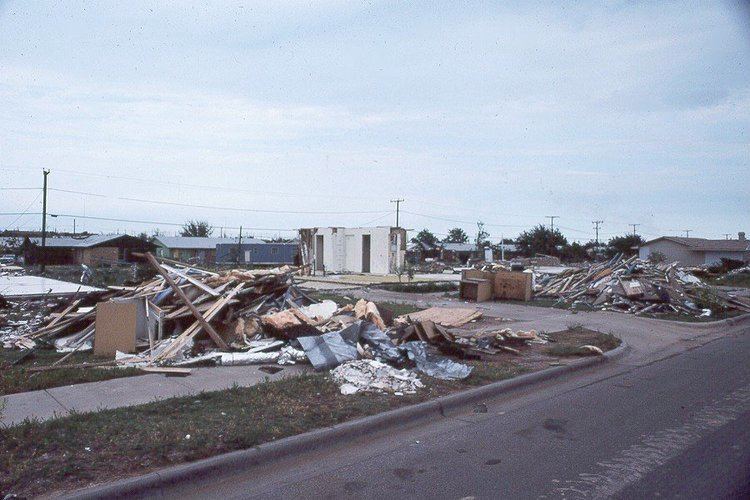Type Tornado outbreak Tornadoes confirmed 59 confirmed Duration of tornado outbreak 2 days | Duration April 10–11, 1979 Max rating Damage unknown | |
 | ||
The 1979 Red River Valley tornado outbreak was a tornado event that occurred on April 10, 1979, near the Red River Valley. It is noted for the F4 tornado that hit Wichita Falls, Texas, and is commonly referred to as "Terrible Tuesday" by many meteorologists. Additional ones were reported across the Southern Plains as well as in the Mississippi River Valley on April 10–11, 1979.
Contents
Formation of the tornadoes
A deepening low pressure system formed in Colorado as a warm front lifted north pulling warm, moist, unstable air. There was strong upper level dynamics all coming together to produce strong tornado-producing supercells. In the early afternoon hours, three supercell thunderstorms formed. They moved northeastward, and as a trio spawned families of tornadoes. These supercells caused the most damaging tornadoes of the outbreak.
The first tornado formed near Crowell, Texas, at around 3:05 p.m. About 35 minutes later, the first killer one of the outbreak ripped through Vernon and killed 11 people. Then the supercell spawned one that killed three people in Lawton, Oklahoma. The second supercell spawned one that moved 64 miles (103 km).
Wichita Falls, Texas
The third supercell was the one that formed the Seymour and Wichita Falls tornadoes as part of a three-member tornado family. The first one formed near Seymour at around 4:53 pm. The storm spawned a second one and moved through the south and east sides of Wichita Falls at around 6:00 pm. The third member of the family formed near Waurika, Oklahoma, at around 8:00 p.m.
The Wichita Falls tornado formed in Archer County and moved northeast and damaged a few rural homes and high voltage towers. It rapidly intensified as it entered the city near Memorial Stadium by McNiel Jr. High on Southwest Parkway, which was located to the west of Wichita Falls at approximately 6:07 p.m. damaging both structures severely. Hail the size of golf balls preceded the touchdown and continued for approximately 15 minutes. It then became calm before the winds began to pick up.
The massive wedge tornado, which was at its maximum 1.5 miles (2.4 km) wide, cut a 2.5-mile (4.0 km) swath of destruction through the south side of town, leveling everything in its path. It destroyed an apartment complex near the beginning of its path. It also took its first lives there. It later destroyed a restaurant, the majority of Sikes Senter, the major mall, and another apartment complex where it took more lives. Neighborhoods all along Southwest Parkway were leveled and nothing but debris and destruction remained.
A number of people tried to flee as the tornado moved along U.S. Highways 281 and 287. Several people were killed in their cars. It then moved into Clay County and changed its appearance to display a multiple-vortex structure. There were at times 5 separate vortices visible within the tornado. It inflicted additional damage south of Dean and Byers, but no more fatalities occurred. It crossed into Oklahoma where additional damage occurred before it dissipated.
Damage
At the end of the outbreak, 54 people lost their lives in Texas, three were killed in Oklahoma and one was killed in Indiana. The Wichita Falls tornado alone killed 42 people and caused $400 million in damage. An 8 miles (13 km) swath of the city had significant devastation.
